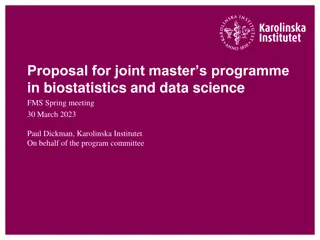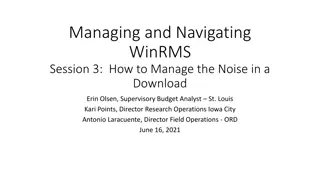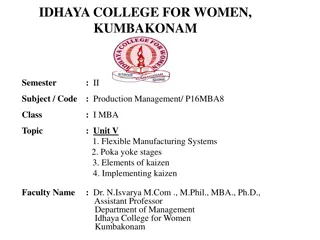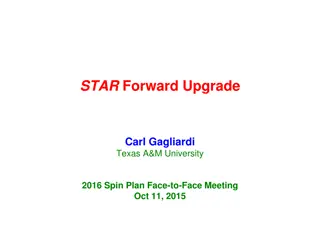
Evolution of Flexible Manufacturing Systems and CAD/CAM Technology
Explore the history and evolution of Flexible Manufacturing Systems (FMS) from post-WWII to the adoption of CAD/CAM technology. Understand how FMS emerged as a competitive advantage strategy by enhancing flexibility, efficiency, and quality in manufacturing. Discover the transition from hardwired systems to advanced NC machines controlled by computers.
Download Presentation

Please find below an Image/Link to download the presentation.
The content on the website is provided AS IS for your information and personal use only. It may not be sold, licensed, or shared on other websites without obtaining consent from the author. If you encounter any issues during the download, it is possible that the publisher has removed the file from their server.
You are allowed to download the files provided on this website for personal or commercial use, subject to the condition that they are used lawfully. All files are the property of their respective owners.
The content on the website is provided AS IS for your information and personal use only. It may not be sold, licensed, or shared on other websites without obtaining consent from the author.
E N D
Presentation Transcript
Ch. #1 Introduction to Flexible Manufacturing Systems (FMS) March, 2020
Outline: History of FMS The Principle objectives of FMS Basic Components of FMS Flexibility in Manufacturing Types of FMS Types of FMS layouts Adv. and Disadv. of FMS and, Application areas of FMS
1.1. History of Flexible Manufacturing System In the beginning, there was not much competition and so FM systems were not needed. After WWII, market focused on consumer (not manufacturer). The first FM system was patent in 1965 by Theo Williamson who made numerically controlled machines.
Contd Change in Manufacturing over time: 60 s - Efficiency in manufacturing 70 s - Efficiency and quality 80 s- Efficiency, quality and flexibility. Thus, companies are forced to adapt itself to: Increased international competition The need to reduce manufacturing cycle time Pressure to cut production costs React in the case of changes.
Contd A new strategy was formulated (Customizability). The companies have to adapt to the environment in which they operate, to be more flexible in their operations and to satisfy different market segments. Thus the innovation of FMS became related to the effort of gaining competitive advantage.
Contd FMS is considered as a natural evolution of the technology of CAD/CAM which by itself evolved by the integration of CAD and CAM. MIT - USA is credited with pioneering the development in both CAD and CAM. The need to meet the design and manufacturing requirements of aerospace industries after the WWII necessitated the development these technologies.
Contd The first major innovation in machine control is the Numerical Control (NC), demonstrated at MIT in 1952. Early NC Systems were all basically hardwired systems, since these were built with discrete systems. Every NC machine was fitted with a tape reader to read paper tape and transfer the program to the memory of the machine tool block by block. Mainframe computers were used to control a group of NC machines by mid 60's. This arrangement was then called Direct Numerical Control (DNC) as the computer bypassed the tape reader to transfer the program data to the machine controller.
Contd By late 60's mini computers were being commonly used to control NC machines. At this stage NC became truly soft wired with the facilities of mass programstorage, offline editing and software logic control and processing. This development is called Computer Numerical Control (CNC). A further development to this technology is the distributed numerical control (DNC) in which processing of NC program is carried out in different computers operating at different hierarchical levels - typically from mainframe host computers to plant computers to the machine controller.
Contd Robots were introduced to automate several tasks like machine loading, materials handling, welding, painting and assembly. All these developments led to the evolution of flexible manufacturing cells and flexible manufacturing systems in late 70's. A manufacturing cell in its broadest sense implies the logical arrangements of standalone manual or NC equipment into groups or clusters of machines to process parts by part family,
Contd Processing parts in the manufacturing cell includes completing as much as the work piece processing as possible within the cell before moving it to the next sequential processing stock inspection or assembly station. Today the term manufacturing cell is much broader and further implies some level of automated part loading, unloading, delaying or exchange to the clustered machines. Thus, these advancements in manufacturing led to the development of flexible manufacturing system.
1.2. FMS Defn. A FMS is multiple machines that are integrated by an automated material handling system whose operation is managed by a computerized control system. FMS consists of a group of processing work stations interconnected by means of an automated material handling and storage system and controlled by integrated computer control system. # FMS is called flexible due to the reason that it is capable of processing a variety of different part styles simultaneously at the workstation and quantities of production can be adjusted in response to changing demand patterns.
Contd An Industrial FMS consists of robots,Computer-controlled Machines, computers, sensors, and other stand-alone systems such as inspection machines as shown in Figure 1. Fig. 1 Illustrations of FMS
Contd The FMS is most suited for the mid-variety &mid-volume production. Fig 3. Application Characteristics of FMS
What are the features of FMS? An FMS is distinguished from an automated production line by its ability to process more than one product style simultaneously. At any moment, each machine in the system may be processing a different part type. FMS can let us make changes in production schedule in order to meet the demands on different products. 14
Differences between FMS and FMC FMC FMS Has two or three machines Has four or more machines Lack central computer for Larger and more control, rather controlled sophisticated computer by cell controller Higher effect of machines control system failurity Minimized effect of machine breakdowns 15
1.3. Objectives of FMS The principle objectives of FMS are 1. To improve operational control through: Reduction in the number of uncontrollable variables Providing tools to recognize and react quickly to deviations in the manufacturing plan Reducing the dependence of human communication. 2. To reduce direct labor: Removing operators from the machining site Eliminating dependence on highly skilled machines Providing a catalyst to introduce and support unattended or lightly attended machining operation.
Contd 3. To improve short run responsiveness consisting of: Engineering changes Processing changes Machining downtime Cutting tool failure Late material delivery 4. To improve long-run accommodations through quicker and easier assimilation of: Changing product volumes New product additions and introductions Increase machine utilization
1.4. Basic Components of FMS The basic components of FMS are: 1) Workstations 2) Automated Material Handling and Storage system 3) Computer Control System.
i. Workstations In present day application, these workstations are typically computer numerical control (CNC) machine tools that perform machining operation on families of parts. The various workstations are: i. Machining centers ii. Load and unload stations iii. Assembly work stations iv. Inspection stations v. Forging stations vi. Sheet metal processing, etc.
ii. Automated Material Handling and Storage System The various automated material handling systems are used to transport work parts and subassembly parts between the processing stations. It consists of power vehicles, robots, conveyers, automated guided vehicles (AGVs), and other systems to carry parts between workstations. The various functions of automated material handling and storage system are: Random and independent movement of work parts between workstations Handling of a variety of work part configurations Temporary storage Convenient access for loading and unloading of work parts
iii. Computer Control System (CCS) It is used to control the activities of the processing stations and the material handling system in the FMS. The various functions of CCS are: Control of each machine tools Production control Workpiece and tool control Traffic control Work handling system and monitoring System performance monitoring and reporting
1.5. Flexibility in Manufacturing Flexibility in manufacturing means the ability to deal with slightly or greatly mixed parts, to allow variation in parts assembly and variations in process sequence and change the production volume. There are three levels of manufacturing flexibility. 1) Basic flexibilities 2) System flexibilities and, 3) Aggregate flexibilities
(a) Basic flexibilities Machine flexibility: The ease with which a machine can process various operations. Material handling flexibility: A measure of the ease with which different part types can be transported and properly positioned at the various machine tools in a system. Operation flexibility: A measure of the ease with which alternative operation sequences can be used for processing a part type.
(b) System flexibilities Volume flexibility :A measure of a system s capability to be operated profitably at different volumes of the existing part types. Expansion flexibility: The ability to build a system to expand it incrementally. Routing flexibility: It can define as capacity to produce parts on alternative workstation in case of equipment breakdowns, tool failure, and other interruptions at any particular station. Process flexibility: A measure of the volume of the set of part types that a system can produce without incurring any setup. Product flexibility: It refers to ability to change over to a new set of products economically and quickly in response to the changing market requirements.
(c) Aggregate flexibilities Program flexibility: The ability of a system to run for reasonably long periods without external intervention. Production flexibility: The volume of the set of part types that a system can produce without major investment in capital equipment. Market flexibility: The ability of a system to efficiently adapt to changing market conditions.
1.6. Flexibility test Flexibility has three primary capabilities in the FMS; it must have the capability: to identify and distinguish among the different incoming part or product styles processed by the system; of performing a quick changeover of operating instructions; and of performing a quick changeover of physical set-up. These capabilities are expressed in various ways in the FMS, which can best be seen from an example such as is provided in Figure next. This figure depicts an automated manufacturing cell with two machine tools and robot. The question arising from this figure is: is it a flexible cell? To be considered flexible there are four reasonable tests that can be applied to the system to determine its level of flexibility.
Contd Flexibility test: 1) Part variety test can the system process different part styles? 2) Schedule change test can the system readily accept changes in the production schedule, either in the product mix or the expected production volume? 3) Error recovery test can the system recover gracefully from equipment malfunctions and breakdowns, so that production is not completely disrupted? 4) New part test can new part designs be introduced into the existing product mix with relative ease?
Contd The system is flexible if we can answer yes to all of these questions, with the most important criteria for flexibility being numbers 1 and 2. Numbers 3 and 4 are softer criteria that may be implemented at various levels. In Figure, the automated manufacturing cell with two machine tools and robot shall be considered flexible if it: 1) can machine different part mixes taken from the carousel by the robot; 2) allows for changes in the production schedule, without affecting the operation of the robotic arm and the two machine tools; 3) is able to carry-on operating even if one machine tool breaks down; and 4) can accommodate new part designs if the numerical control programme to do so is written off-line and then downloaded by the system for execution.
1.7. Types of FMS FMS can be distinguished by how they perform, as either processing operations or assembly operations. FMS are custom-built so that we may expect to find a wide range of types have been implemented to suit differing projects. Each FMS is customized and unique; however, we can still define a types for FMS depending on: 1) the number of machines it contains; or 2) Level of flexibility (whether it is a dedicated or random- order FMS, in terms of the parts it processes.).
i. Based on the Number of Machines: 1. Single machine cell: It contains one machine (often a CNC machining centre) connected to a parts storage system, which can load and unload parts to and from the storage system . When it operates in flexible mode, the system satisfies three of the four tests for flexibility the exception being error recovery, since, if the CNC machine centre breaks down, the system stops.
2. Flexible manufacturing cell: contains two or three processing workstations (often CNC machining or turning centres), plus a parts handling system. This set-up can operate in flexible mode and batch mode, as necessary, and can readily adapt to evolving production schedule and increased production volumes. Since there is more than one machine, error recovery is possible by re-routing the failed machine s intended parts for processing to the other two machines in the system; and new part designs can be introduced with relative ease into the set-up. The flexible manufacturing cell satisfies all four flexibility tests.
3. Flexible manufacturing system (FMS) > consists of four or more processing stations connected mechanically by a common parts handling system and electronically by a distributed computer system. > FMS is larger than the flexible manufacturing cell, not only in the number of workstations it may contain, but also in the number of supporting stations in the system, such as part/pallet washing stations, co-ordinate measuring machines, storage stations and so on. > Computer control is also more sophisticated; it includes functions not found in the FMC such as diagnostics and tool monitoring. The FMS satisfies all four flexibility tests.
Contd Fig. Plan view of a seven-station flexible manufacturing system
Contd A comparison of the three FMS types is illustrated in Figure, where the number of machines is plotted against metrics of investment, production rate and annual volume. Features of the three categories of flexible cells and systems Features of the three categories of flexible cells and systems
ii. Types of FMS based on level of flexibility: 1) Sequential FMS: It manufactures one-piece part batch type and then planning and preparation is carried out for the next piece part batch type to be manufactured. It operates like a small batch flexible transfer line. 2) Random FMS: It manufactures any random mix of piece part types at any one time. 3) Dedicated FMS: It continually manufactures, for extended periods, the same but limited mix of piece part batch types. 4) Engineered FMS: It manufactures the same mix of part types throughout its lifetime. 5) Modular FMS: A modular FMS, with a sophisticated FMS, enables FMS user to expand their FMS capabilities in a stepwise fashion into any of the previous four types of FMS.
1.8. Types of FMS layouts I. Progressive or Line Type II. Loop Type III. Ladder Type IV. Open field type and V. Robot centered type
i. Progressive or Line type The machines and handling system are arranged in a line as shown in the Fig.. It is most appropriate for a system in which the part progress from one workstation to the next in a well defined sequence with no back flow. The operation of this type of system is very similar to transfer line type. Work always flows in unidirectional path.
ii. Loop Type The basic loop configuration is as shown in Fig.. The parts usually move in one direction around the loop, with the capability to stop and be transferred to any station. The loading and unloading station are typically located at one end of the loop.
iii. Ladder Type The configuration is as shown in Fig.. The loading and unloading station is typically located at the same end. The sequence to the operation/transfer of parts from one machine tool to another is in the form of ladder steps as shown in Fig.
iv. Open Field Type The configuration of the open field is as shown in Fig. The loading and unloading station is typically located at the same end. The parts will go through all the substations, such as CNC machines, CMMs and wash station by the help of AGV s from one substation to another.
v. Robot Centered Type Robot centered type is a relatively new form of flexible system in which one or more robots are used as the material handling systems as shown in Fig.. Industrial robots can be equipped with grippers that make them well suited for handling of rotational parts.
1.9. Adv. and Disadv. of FMS implementation Advantages: Faster and lower-cost changes from one part to another which will improve machine utilization. Lower direct labor cost due to the reduction in number of workers. Fewer machines required because existing machines are highly flexible, and because of higher machine utilization Reduced inventory due to the planning and programming precision. Consistent and better quality due to the automated control. Lower cost/unit of output due to the greater productivity using the same number of workers. Savings from the indirect labor cost from reduced errors, rework, repairs and rejects.
Contd Disadvantages: Limited ability to adapt to changes in product or product mix Substantial pre-planning activity Expensive, costing millions of dollars Technological problems of exact component positioning and precise timing necessary to process a component Sophisticated manufacturing systems.
1.10. Application areas of FMS The ff chart shows various applications areas in an industry.
Summary Flexibility in manufacturing system is one of the most important issues of present scenario, to fulfill the desired customer s requirement & getting low cost and high quality of product that enforced to adopting the FMS for various modern manufacturing enterprises. The basic of FMS is to convert & increases positivity throughout the manufacturing process for achieving higher productivity and best quality of product. FMS consists of an integrated system of computerized numerically controlled (CNC) machine tool , automated material handling system operating under the controlled computer , workstation, storage etc. In this lecture session, it is also tried to highlight the types of flexibility, flexibility test, FMS layouts, adv & disadv and application of FMS and also overviewed of other aspect of FMS.
Self-Assessment Questions 1) What is meant by a flexible manufacturing system? 2) What are the four tests for flexibility in FMS research? 3) How are different types of FMS specified? 4) What are the basic components of FMS? 5) List the five categories of FMS layout. 6) What are the benefits of a successful FMS implementation? 7) Cite the main application areas of FMS.



















